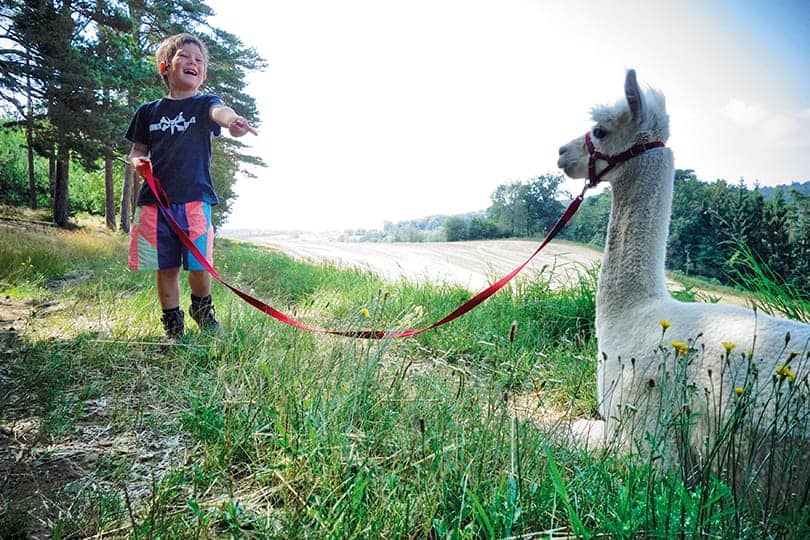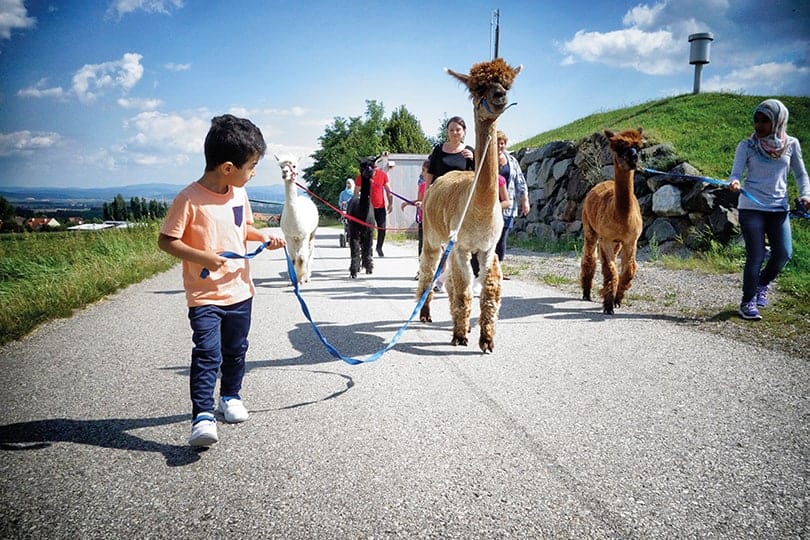Loud child calls and excited ringing, in between a few "Wows" and a few "Aahs". When the seven-member family Aigner pulls up with their bicycles, it can be hectic. If your excursion destination is like the alpaca pasture of the Horvat family today, then childish turbulence mixes with the warm summer air. Four boys between the ages of nine and nine, the three older ones are running around uneasily. Tim is five years old and has recently become the second youngest. That bothers him, his parents tell. He walks away hiding nervously behind a tree. A few minutes later he keeps Alpaca Fritz on a leash, his brothers do the same and take over the care of Lars and Fibo. And suddenly: silence. Papa Thomas clearly describes his observations with surprise: "The second they were with the animals, my boys calmed down. We could now measure that with a DB meter. This morning, and until recently, they were still very excited, loud and tumultuous. Now they are very relaxed. I think they are as impressed as me. "
Mindful, popular and fluffy
Alpacas belong to the camels family and are originally from the Andes in South America. For a long time they have been at home in Austria and are mainly bred for their fluffy wool. Gabriele Horvat holds five alpacas on a pasture in Karlstetten in Lower Austria, the "Alpakas point of light" - she especially appreciates the extremely level-headed character of the animals: "Alpacas exude a very special kind of calmness, which passes to humans. You get the feeling that worries, stress and stress in everyday life just flow away as soon as you get close to the animals. That was the reason why I fell in love with alpacas. "As a life coach and energy therapist, she often deals with people who experience such stress in everyday life. So she had the idea to share her good experiences with alpacas in the future with her clients, she says. Gabriele Horvat and her daughter Laura have been offering animal-assisted leisure activities in the field of consulting and coaching for about a year. Or as hiking days for school classes. Or as a family outing on a sunny Saturday afternoon - like the one with the Aigner family.
INFO: Animal Therapy
Working with animals is used in many disciplines, including psychotherapy, pedagogy, psychology and life coaching. "Animal-assisted interventions" are the collective term for this work. While the use of the term "therapy" is not regulated by law, it is sensitive because it is closely linked to the main occupation and thus to specific training. The European Society for Animal Assisted Therapy (ESAAT) defines it as follows: "Animal Assisted Therapy" includes deliberately planned educational, psychological and socio-integrative offerings with animals for children, adolescents, adults and adults with cognitive, social-emotional and motor impairments, behavioral disorders and special needs. It also includes health-promoting, preventive and rehabilitative measures. "
The effect of animals on humans is explained by Helga Widder, Managing Director of the association "Animals as Therapy" with the biophilia hypothesis of Edward O. Wilson: "We are part of nature and, as such, also integrated into the cycle of nature. This provides an instinctual anchorage and a very close, subconscious connection with processes that represent the flow of nature. "This explains the deep, subconscious communication between human and animal. "For these animal-assisted interventions to work, there must be a close connection between the pet owner and his pet. You have to understand each other blindly and trust blindly, then you can also incorporate other people into this relationship. "
Animal-assisted interventions are promoted in Austria by individual private institutions, but not paid by the health insurance. For Helga Aries, that would be an important point: "If you look at what success this has with zero side effects, animal-based interventions should be used much more often."
Animals reflect moods

Five-year-old Tim is still holding Alpaca Fritz, walking with him over a dirt road through the hilly landscape around Karlstetten. Why Fritz, I ask him. "I chose Fritz because I felt that he was my friend. He also has such a beautiful, white, cuddly coat. "The initially skeptical look has given way to a contented, self-assured. "He follows me on the foot. Look, I said, come and he comes, "says Tim. This is not always so, because alpacas are very sensitive, perceive the mood that their human companion brings them and reflect them. Laura Horvat, the daughter of Gabriele, has often observed this: "The more loving and respectful the handling of animals is, the more attentive, relaxed and better they are to lead." The reverse conclusion: uncertainties, anxiety or negative moods are also mirrored , Then it can happen that the alpaca just stops and does not do anything anymore. "When children are particularly impulsive and think that they have to extend their elbows, this may work for the classmates, but not for the animals. The recognize in the Rumpelstielzchenmanier one thing above all: uncertainty. "
Valuable animals, self-confident children
For children it is therefore a special sense of achievement to feel the harmony with the animal. "The animals are unbiased and do not value," says Gabriele Horvat, "they treat a behavioral child as well as anyone else. In the interpersonal realm, children are often exposed to prejudices or expectations, whereas alpacas only reflect the actual state. The value freedom of the animals is taken as a basic mood. Now, if a child who otherwise has difficulty interacting with others succeeds in interacting with the animal, it can gain much self-confidence. And that can affect other areas as well, such as learning at school. "
Speaking of school: the main school teacher Ilse Schindler also tells an interesting story, who made a hiking day with her class and the "light point alpacas" of the Horvat family: "A guy, otherwise very restless and quick-tempered, was traveling with one of the alpacas. It could hardly be caressed by someone and avoided with his long neck our attempts to touch again and again. Only this guy was allowed to caress his neck for an endless time. He was very proud and happy with the fact that he was so welcome with the animal. Otherwise, he does not experience it that often. "
More feeling for the needs of others
While Tim is pleased to have "already got the fourth Bussi" from Fritz, Thomas Aigner, the family man, takes over the leash from Alpaka Lars. "Do they actually spit?" He asks attentively. "Only if you really annoy her. Or when they fight power games with each other, then you should not necessarily stand in between, "Laura replies.
Alpacas also have a special effect on adults. Thomas Aigner is himself a psychologist and has a theory ready: "I see through the encounter with the animal, the non-violent, the need-based communication promoted. One learns to consider the animal's needs, to respond to them. If you do not do that, you will not get far with the animals. This trains one's sense of the needs of others. That can also be transferred to dealing with people. "
Sedative Alpaca

I make a touching observation during a Sunday walk with the "Lichtpunkt Alpakas" and the Syrian refugee family Hussein (name changed). A helicopter circling over the summer landscape of Karlstetten. Eight-year-old Farah is frightened, ducking, looking anxiously between the plane and Papa Kaled. He speaks a few soothing words in Arabic and explains: "In Syria, she has seen a barrel bomb dropped by a helicopter. Many people have died. She's scared, alone before the noise. "
But not for long, her gaze wanders back to Alpaca Fritz, whose leash she holds. The animal looks at Farah with a long neck and curious eyes, making a soft, characteristic buzzing sound as if it had perceived the sudden change of mood. Papa Kaled is surprised: "She has never relaxed so fast. Walking with the alpacas calms her a lot. I think doing it more often could help them forget the fears they brought with them from Syria. "
INFO: Animals suitable for animal therapy
Dogs: The oldest human social partner can read us as well as no other animal. Dogs can be trained very well, the body language is particularly important.
Horses: Horses are very sensitive and respond very quickly to people with a reflection of their mood. Especially for building self-confidence, they are well suited.
Alpacas: are known for their very prudent, good-natured and sensitive character; The animals radiate a special peace, which passes to humans.
Cats: have a very short socialization period of a few weeks; Whether they can be used for animal-assisted interventions depends on how their connection to humans has been established during this period.
Agate snails: come out of their house only when the mood is calm and positive; Children can learn to become calmer because they want the snail to come out;
Photo / Video: Horvat.


